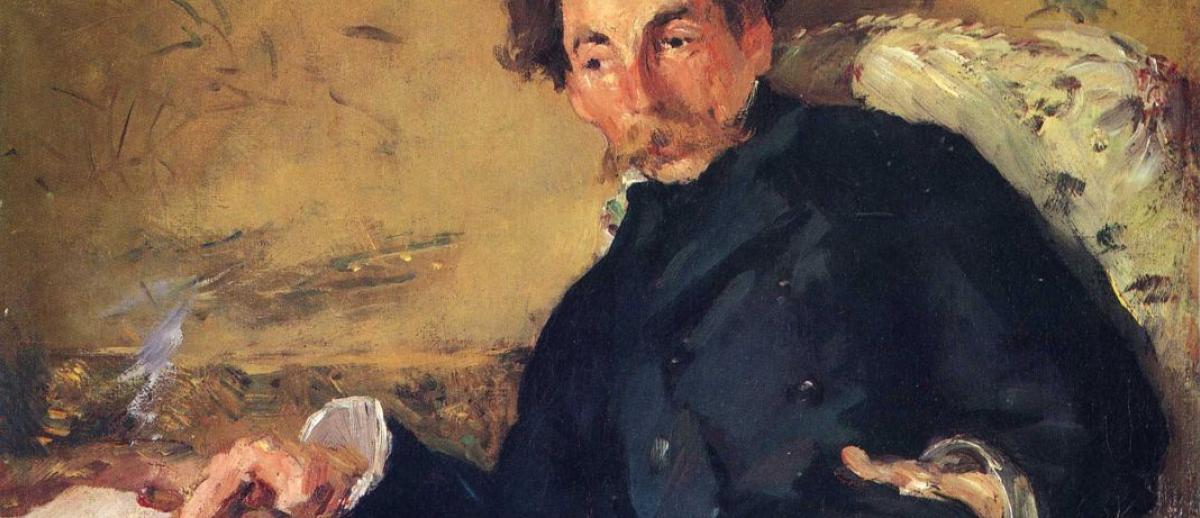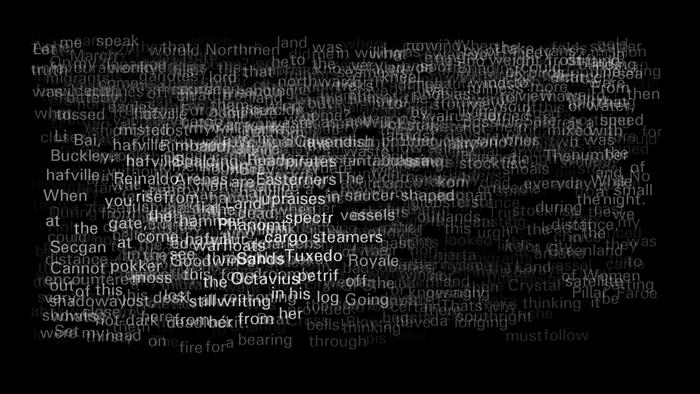‘By way of’: On Poetry, Translation and Translational Poetics
archive


Édouard Manet, 'Portrait of Stéphane Mallarmé', 1876
‘By way of’: On Poetry, Translation and Translational Poetics
What does poetry in translation say about us as global citizens? About the particular ways in which we approach foreignness?
The poem ‘Via’, by French-Norwegian poet and conceptual artist Caroline Bergvall, is composed of 47 translations into English of the first tercet of Canto I of Dante’s Inferno.1 For the translator, Dante’s text presents a particularly challenging prospect: composed of stanzas in the terza rima form—invented by the poet for this particular project—it consists of tercets in which the second line of each stanza sets the end-rhyme for the first and third lines in the stanza that follows, creating a concertina of sound that pushes the text forward. The terza rima is eminently suited to the Italian language, which, I am told, contains many words ending in similar sounds, and a terrible fit for English, which does not. As a result, the usual dilemmas faced by translators of poetry (do you prioritise, for instance, sound or sense?) is magnified, as is the dilemma of the non-Italian reader (which of the hundreds of translation do you read?). Reading, or listening,2 to the 47 versions of the first tercet alone, in Bergvall’s poem, is as clear and concise a lesson as any about the fact that there exists no true parity between languages. If we want to read Dante as non-Italian speakers we must do it in translation, and there is no such thing as a perfect one.
In her discussion of poets like Bergvall (for whom Italian is a foreign language and English is an adopted one), literary critic Marjorie Perloff speaks of what she terms ‘translational poetics’: “a poetics for the twenty-first century that has two poles: multilingualism on the one hand and exophonic writing on the other.”3 Multilingualism is exemplified by works such as Ezra Pound’s Cantos, “with their insertion of Chinese characters, Greek and Latin phrases, lines from Guido Cavalcanti, or passages of American dialect and phonetic spelling.”4 Exophonic writing is typified by “the French poems of Paul Celan or the English lyrics of Fernando Pessoa,”5 and “has become much more common today, thanks to the current state of mobility and migration, in which the use of English (or French or German or Dutch) as a second language has become almost normative.”6 As Perloff writes: “In a world of relentless global communication, poetry has begun to concern itself with the processing and absorption of the ‘foreign’ itself.”7

Painting by Syrian artist Aktham Talla. Image source: Prof. Huda J. Fakhreddine, ArabLit
Perloff’s notion of translational poetics8 is indeed sharply attuned to the particular cultural moment in which we find ourselves, a moment when “foreignness” has become a constant feature of living in a global community, but the “absorption of the ‘foreign’” she identifies as a more recent trend in poetic practice highlights what seems to be a relationship of contiguity that has always existed between poetry and translation. Exophonic writing, as in the example of Bergvall’s ‘Via’, is writing in which the structures of a specific language (or languages), by virtue of being unfamiliar to the writer, are exposed; it is writing in which linguistic borders—in other words, the spaces between and within languages—are made visible.
Since at least the publication of French symbolist poet Stéphen Mallarmé’s groundbreaking poem ‘Un coup de dés’ (in which “[t]he ‘blanks’…assume importance”),9 it has been an accepted maxim that in the writing and reading of poetry, the spaces and silences are as important as the text. Poetic space, in its simplest and most obvious formulation, can refer to the white spaces physically surrounding text: breaks or breaths between lines, stanzas, paragraphs, etc. But the more significant spaces are hidden beneath the ambit of the visible, in the very nature of poetic language.
Novelist and poet Ben Lerner, in the provocatively titled The Hatred of Poetry,10 uses the terms ‘actual’ and ‘virtual’ to discuss the gap between the actual poem (the words on the page) and the ideal or ‘virtual’ poem they strive toward, but never reach.11 This, he says, is one of the reasons why people, even poets—especially poets—hate poetry: it promises so much and never delivers. If the distance between the virtual and the actual is a source of frustration in poetry in general, it is maddeningly so in translated verse. We could extend Lerner’s model on this score in at least two ways. The first would be by placing another level beneath the ‘actual’: the ‘translated’, even further removed from the ‘virtual’. This option, however, belies the fact that translation is not mere word substitution, and is instead always and by necessity an act of rewriting (or ‘imitation’, as the poet Robert Lowell would have it).12 A model that edges perhaps closer to practice would involve: a virtual poem, with its accompanying actual poem in language A; the latter then being used to deduce (or backwards engineer) the virtual so as to attempt to produce another, analogous, actual poem in language B.
I’m sure Lerner himself would have expressed the above in a more elegant way, but the split between virtual and actual, which holds true for both poetry and translation, seems to me to reach the heart of the matter. Later on in The Hatred of Poetry, Lerner writes:
Do you remember the feeling that sense was provisional and that two people could build around an utterance a world in which any usage signified? I think that’s poetry. And when I felt I finally mastered a word, when I could slide it into a sentence with a satisfying click, that wasn’t poetry anymore—that was something else, something functional within a world, not the liquefaction of its limits.13
The first point of relevance here is in relation to the provisional nature of sense. Beyond the realm of childhood, and unless you are dealing with neologisms, what this most practically speaks to is the way in which poetic language, as a mode that does not have as its primary purpose the imparting of clear and unequivocal information, thrives on ambiguity. As poet and linguist Roman Jakobson, quoting literary critic William Empson, argues: “‘The machinations of ambiguity are among the very roots of poetry’…Not only the message itself but also its addresser and addressee become ambiguous.”14
Poetry... offers us, as citizens of a now global world, keys to help recast the manner in which we approach difference, diversity, and foreignness itself.
The second, and connected, point lies in the idea of world-building and destroying. Lerner is not the first to recognise that poetry, through its attention to the structures of language (not simply words, sentences and phrases, but also letters, syllables, phonemes)—through its ability not so much to ‘make it new’, as Ezra Pound would have it, but to make the familiar strange—can liquefy limits. As Earl Wasserman observes: “the extraordinary syntactical possibilities of poetry create a new syntactical order and therefore a new organisation of reality.”15 The poetic text productively unsettles, in the unbridgeable distance that separates the virtual from the actual—a space made more visible by the attention poetry pays to not only the message, but the manner of its transport—our use of language and the ways in which we think we know the world. Poetry makes of one’s own language a foreign country—which is always strange, and in which meaning is always provisional, relational and contested—and in this way inhabits translation as a normative mode. It offers us, as citizens of a now global world, keys to help recast the manner in which we approach difference, diversity, and foreignness itself.

Image still from Caroline Bergvall (with Thomas Köppel), 'Seafarer', 2014. DRIFT exhibition, 2015. Image source
To travel through a foreign text, as through a foreign country, is to be reminded of the ways in which language is both a means and a limit. Caroline Bergvall’s poem ‘Via’, the title of which translates roughly as ‘by way of’, presents us with 47 converging and diverging paths that seek entry into a common source text. A reading of these brings us closer but never entirely proximate to what the original may or may not speak, an original that itself hovers at another set of gates, seeking entry into an ideal space beyond representation. Poetry, as a genre in which language, whether native or adopted, is always made foreign, reminds us that the distance between the virtual and the actual is one that is called into being whenever we write and read, speak and listen; that no parity exists between language and language, language and world, and every act of speech and of writing is an act of translation. We all stand at the gates to places we cannot hope to access, and if we move through texts and worlds it is always, and only, ‘by way of’.
___________________
Bella Li is a PhD candidate at The University of Melbourne. Her first book, Argosy (Vagabond Press, 2017), won the 2018 Victorian Premier’s Literary Award for Poetry and the 2018 NSW Premier’s Literary Award for Poetry. Her second book, Lost Lake (Vagabond Press, 2018), was shortlisted for the 2018 QLD Literary Award for Poetry. Her writing and artwork has been published in journals and anthologies such as Best Australian Poems, Archives of American Art Journal (US) and The Kenyon Review (US), and exhibited in the Triennial of the National Gallery of Victoria.
1. The full text, from Bergvall’s collection Fig (Cambridge: Salt, 2005), can be read here: http://carolinebergvall.com/wp-content/uploads/2018/08/VIA.pdf. Note that this version differs in appearance from the poem’s first print publication in the journal Chain (2003), which can be read here: http://writing.upenn.edu/~afilreis/88v/bergvall-via.html.
2. The poem was first presented as a sound recording, read by Bergvall, which can be found here: https://soundcloud.com/carolinebergvall/via-48-dante-translations-mix.
3. Marjorie Perloff, Unoriginal Genius: Poetry by Other Means in the New Century, Chicago: University of Chicago Press, 2010, p. 16.
4. Ibid.
5. Ibid.
6. Ibid.
7. Ibid., p. 129.
8. More nuanced than the brief snapshot I’ve provided here.
9. Stéphen Mallarmé, Collected Poems, translated by Henry Weinfield, Berkeley: University of California Pres, 1994, p. 121 (from the Preface by the poet). The poem was first published in 1897.
10. Ben Lerner, The Hatred of Poetry, Melbourne: Text Publishing, 2016.
11. Ibid., pp 8–9. The terms have been borrowed, Lerner tells us, from critic Allen Grossman.
12. In the introduction to Imitations, Lowell’s 1978 book of ‘translations’ of a number of significant European poems, the poet states: ‘I believe that poetic translation—I would call it an imitation—must be expert and inspired, and needs at least as much technique, luck and rightness of hand as an original poem.’ Robert Lowell, Imitations, New York: Farrar Straus and Giroux, 1978, p. xii. See, also, the blurb by A. Alvarez on the back cover: ‘Not a book of translations; it is a magnificent collection of new poems by Robert Lowell, based on the work of 18 European poets.’
13. Lerner, pp. 79–80.
14. Roman Jakobson, ‘Closing Statement: Linguistics and Poetics’, in Style in Language, edited by Thomas A. Sebeok, Massachusetts: MIT Press and John Wiley, 1960, pp. 350–77, p. 369.
15. Earl R. Wasserman, The Subtler Language: Critical Readings of Neoclassic and Romantic Poems, Baltimore: John Hopkins Press, 1959, p. 9.
Bergvall, Caroline, Fig, Cambridge: Salt, 2005.
Jakobson, Roman, ‘Closing Statement: Linguistics and Poetics’, in Style in Language, edited by Thomas A. Sebeok, Massachusetts: MIT Press and John Wiley, 1960, pp. 350–77.
Lerner, Ben, The Hatred of Poetry, Melbourne: Text Publishing, 2016.
Lowell, Robert, Imitations, New York: Farrar Straus and Giroux, 1978.
Mallarmé, Stéphen, Collected Poems, translated by Henry Weinfield, Berkeley: University of California Pres, 1994.
Perloff, Marjorie, Unoriginal Genius: Poetry by Other Means in the New Century, Chicago: University of Chicago Press, 2010.
Wasserman, Earl R., The Subtler Language: Critical Readings of Neoclassic and Romantic Poems, Baltimore: John Hopkins Press, 1959.



